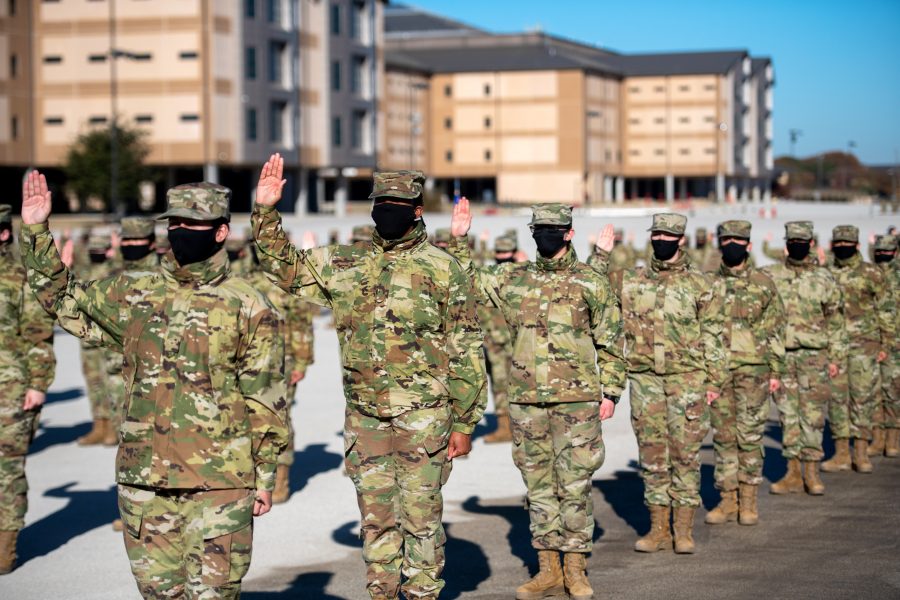The Space Force spent its first year transforming how the military is organized, trained, and equipped to wield satellites, radars, and other capabilities in combat. It will spend its second year proving whether those changes can work.
As the newest service turns 1 year old on Dec. 20, it is preparing to welcome in thousands more recently selected Airmen in fields such as intelligence and acquisition next year. It plans to grow to 6,400 Active-duty members by the end of September, and total about 16,000 employees including civilians and members assigned from other branches. About 2,400 Active-duty personnel are part of USSF now.
“Now we have to develop those folks to fill those positions and do that organically from the United States Space Force, … focused on the domain of which we are responsible for, and being able to move at speed,” Chief of Space Operations Gen. John W. “Jay” Raymond said on a Dec. 15 call with reporters.
“As new missions come about, we will add squadrons as those missions materialize,” he added.
Chief Master Sergeant Roger A. Towberman, the Space Force’s Senior Enlisted Adviser, said the service is figuring out when it makes sense to bring those new members in “one by one.” People in career fields shared by both the Air Force and Space Force—cyber, intel, acquisition, and others—who were tapped for transfer can start joining Feb. 1, 2021.
“When’s the right time for this person to swap out?” Towberman said. “I wouldn’t say we’re in a hurry to do that. But there certainly is a sense of urgency, there’s a sense of excitement. We want to make sure that we can move as quickly as practical.”
He suggested that, in some cases, it may make more sense to keep people in their Air Force jobs longer before bringing them into the Space Force. Members of the Army and Navy departments will be allowed in starting on a limited basis next year.
Space operators who work with satellites and related technologies began transferring in September. The service has also begun picking people for promotion through selection boards, including three chief master sergeants who will pin on the new rank at the beginning of 2021.
The Space Force will release its plan for a reserve component in the next few weeks, Raymond said. That’s likely to offer more flexibility or opportunities than the Reserve and Guard pieces of other armed forces, and the general said it could serve as a pathfinder for the rest of the military.
A human capital strategy should come to fruition soon that will introduce new ideas for recruitment, retention, and training. The Space Force argues that its small size relative to the rest of the military makes it an ideal guinea pig for more modern approaches to personnel management.
“We still have a lot of work to do to finalize that strategy and fill in some of the blanks. We’ve been holding writing conferences over the last few weeks to be able to do that,” Raymond said. “This will be the most important thing that the Space Force does in the next few months, because it’s going to provide us the means to recruit, attract, assess, develop, and retain a force that we need to be able to operate in space.”
On Dec. 16, Raymond will host a summit of USSF general officers to refine the service’s plans and strategies for offering space power to commanders around the world.
The Joint Chiefs of Staff is set to welcome Raymond as its eighth member on Dec. 20, too. He has sat in on those meetings for the past year, and the congressionally directed move further ingrains space issues into high-level decision-making.
“This next year is all about integrating the Space Force more broadly,” Raymond said. “I do see us integrating with the joint force to a greater extent now that we’re up and running and have built a service, looking at how do you do that force presentation?”
That planning extends to closer collaboration with commercial industry and other nations, too.
“We’ll continue to open up additional training opportunities for allied partners,” he said. “We just put an officer into the Space Operations Command in France. We’ll continue to do that as we also continue to take space professionals from our partners into our ops centers as well.”
Raymond pointed to other instances where the force continues to evolve. For one, the Department of the Air Force has settled on a plan for how the Space Systems Command will manage hardware and software development and sustainment. That needs Air Force Secretary Barbara M. Barrett’s approval but is expected to get up and running in 2021.
“I’m really pleased with how it’s turned out,” Raymond said. “This builds on [the Space and Missile Systems Center’s reforms] that builds some unity of effort and allows … competition between disruptors and prototypers and more traditional acquisition organizations.”
The Space Force is slated to join the Intelligence Community for a closer relationship with organizations such as the National Reconnaissance Office, which operates multiple intel-gathering satellites.
Raymond also noted that he signed a memorandum of understanding with the Japanese government on Dec. 15 to solidify a space payload-hosting partnership. Through that collaboration, two U.S. space domain awareness systems will hitch a ride on Japanese navigation satellites. That frees up American agencies from spending money on more satellites to carry those payloads itself.
The four-star said he won’t speculate on how the incoming Biden administration approach to space might differ. He met with the group overseeing the Defense Department’s transition to the new administration earlier this month for a “really good conversation,” but declined to offer details.
“What isn’t going to change is my focus, and the focus of our team … on building a service that delivers national advantage,” he said.
